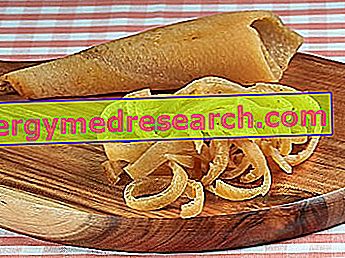Generality
In the gastronomic field, the term carbonara indicates an accompanying sauce for dry pasta. Generally, the pasta shapes that are best combined with carbonara are spaghetti, but there are also recipes with penne, linguine or fusilli.

Nutritional Features
Carbonara is a high-calorie sauce, with a prevalence of lipids to which the intake of proteins (with a high biological value) and of carbohydrates are added. The distribution of fatty acids is in favor of the unsaturated ones, but the saturated ones reach an alarming quantity to say the least; be clear, in sporadic consumption and in adequate portions, carbonara is NOT a POISON for the organism! However, if the diet consists mainly of recipes of the same category, even occasional consumption can become a risk factor for the health of the subject. This significant presence of saturated fatty acids, related to a very high cholesterol intake, in the medium and long term could be responsible for the worsening of lipemia, in particular the increase in total cholesterol and LDL (bad cholesterol); it is useless to remember that the alteration of these two blood parameters represents one of the most known and significant cardio-vascular risk factors.
With regard to mineral salts, the carbonara is particularly rich in sodium, respectively contained in the salt used for processing guanciale (or pancetta) and cheese. This element, if constantly in excess, is responsible for the worsening of the arterial blood pressure, up to reaching (in some subjects) the pathological state called hypertension. People who are overweight, those who are familiar with the disease and sedentary are more exposed to this risk. Hypertension also increases cardiovascular risk in a very important way.
In addition to sodium, calcium, phosphorus and iron levels are also excellent among minerals.
| Composition for: 100g of Classic Carbonara (See Recipe Below) | |||||||||||||||||||||||||||||||||||||||||||||||||||||||||||||||||||||||||||||||||||||||||||||||||||||||||||||||||||||||||||||||||||||||||||||||||
 | |||||||||||||||||||||||||||||||||||||||||||||||||||||||||||||||||||||||||||||||||||||||||||||||||||||||||||||||||||||||||||||||||||||||||||||||||
Nutritional values (per 100 g of edible portion)
| |||||||||||||||||||||||||||||||||||||||||||||||||||||||||||||||||||||||||||||||||||||||||||||||||||||||||||||||||||||||||||||||||||||||||||||||||
As far as vitamins are concerned, carbonara is very rich. The concentrations of thiamine (vit. B1), riboflavin (vit. B2), niacin (vit. PP), pyridoxine (vit. B6), biotin (vit. H), folate, retinol (vit. A) and calciferol ( vit. D); some of these are not mentioned in the table.
Ultimately, it cannot be denied that carbonara is a rather nutritious food; however, in light of what is shown for saturated fatty acids, cholesterol and sodium, it is recommended to use it sporadically, not systematically and, above all, in portions that do NOT exceed 50g of sauce for 80-90g of dry pasta. It is totally excluded in the diet of hypercholesterolemics, hypertensives and obese; even pregnant women must do without it, not so much for their nutritional content as for the hygiene risk associated with raw eggs.
Traditional Carbonara Recipe
The classic carbonara recipe is quite simple. The ingredients for 4 people are:
- diced pork cheek (120-150g)
- egg yolks (3 or 4)
- egg white (1)
- pecorino romano (50-80g)
- coarse ground black pepper (QB)
- semolina pasta (dry 320g)
- coarse salt (QB).
The traditional procedure is equally simple and involves: boiling the slightly salted water and then throwing the pasta; in the meantime, brown the bacon in small cubes in a pan and, separately, beat together: the yolks, egg whites, pecorino cheese and black pepper forming an appearance. To conclude the sauce, it is therefore sufficient to incorporate the pillow into the sauce, which will be added to the well-drained pasta, mixing thoroughly in a bowl (NOT on the fire, since the egg would thicken quickly).
Review with Less Fat and Calories
On the other hand, without distorting this formula too much, it is possible to obtain a decidedly less caloric dish; attention, however, as we will see in the description of the procedure, is the attention to detail that makes the difference!
The ingredients for 4 people of a possible light variant are:
- small diced bacon (150g)
- egg yolks (2) and egg white (1)
- milk (3 tablespoons)
- fine grated Parmesan cheese (2-3 tablespoons)
- big flaky pecorino cheese (50g)
- coarse ground black pepper
- pasta with inulin (pasta for diabetics, 320g dry)
- coarse salt (QB).
Procedure: boil the slightly salted water and then toss the pasta; in a non-stick frying pan or in lava stone, fry, brown the pork cheek cut into small cubes with the lowest possible flame (it will take more than 10 ', the time to boil the water and cook the pasta). In the meantime, apart, compose the appareil with egg yolks, egg white, milk, Parmesan cheese and pepper. Therefore, drain all the fat exuding from the pillow and pat the cubes with absorbent paper. Drain the pasta "Al dente" and sauté over low heat in the pan with the pillow. So, add the appareil, mix, and add the pecorino too. If necessary (if too tied) adjust the consistency with other milk; on the contrary, if the pasta has not been drained well and has diluted the appareil too much, place it in a bowl and leave it covered for 2 minutes, stirring occasionally.
It may appear to be a slightly different carbonara variant than the previous one and, at first glance, it has anything but the appearance of a "light" recipe. Nevertheless, by correctly performing the described procedure, the estimate of the total lipids is easily reduced by 50g; in practice, each diner will introduce up to 12-13g less fat. If we then consider the choice of pasta with inulin, the reduction of the yolks and the incorporation of milk, the energy reduction can reach and exceed 15-18% compared to the first case.
Spaghetti Carbonara Leggeri
X Problems with video playback? Reload from YouTube Go to Video Page Go to Video Recipes Section Watch the video on youtubeAnd for lovers of vegan recipes ... the video of the fake vegan carbonara
Background
Carbonara, unlike amatriciana, has rather confused roots.
The hypotheses on its real ideation are different and all rather plausible, albeit very different. The first is, listen-hear, attributable to American influence; in fact, analyzing the various texts that date back to the pre-World War II era, there are no traces of the carbonara recipe. Only with the arrival of the allied troops (American), and the consequent importation of the bacon, began to observe the progressive spread of the typical seasoning based on bacon, eggs and cheese. The second hypothesis, which however cannot exclude the previous one, attributes the merit to the Apennine charcoal burners (Abruzzo, Umbria, etc.). They, who used to consume a dish called "cacio e ova" during the long vigils of the charcoal kilns, may have evolved the recipe by adding the guanciale (peppered) or lard; this formula does not include the addition of olive oil, too expensive for this social class.
The third hypothesis, which is also pertinent and which does not reject the previous ones, awards merit to Neapolitan cuisine. Supporting this eventuality is the awareness that, in the Neapolitan gastronomic tradition, the condiment in question is widely used as an additional enrichment for many other recipes.
Depending on the conjecture you prefer, the carbonara can include the bacon or smoked bacon (alter ego of the American bacon).



